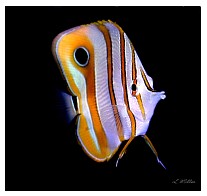Past Issues  2009
2009  August 2009
August 2009  Fish Profile
Fish Profile
 2009
2009  August 2009
August 2009  Fish Profile
Fish Profile
Stats:
 | Today | 3373 |
 | Yesterday | 4618 |
 | This week | 45775 |
 | Last week | 54704 |
 | This month | 69618 |
 | Last month | 217069 |
 | All days | 34083136 |
We have: 40 guests, 1 bots online
Your IP: 18.189.141.66
Mozilla 5.0,
Today: May 09, 2025
Your IP: 18.189.141.66
Mozilla 5.0,
Today: May 09, 2025
Fish Profile
Copperband Butterfly fish, Chelmon rostratus |
|
|
Photos courtesy of Lisa Miller
| Common Name: | Copperband Butterfly Fish, Beaked Butterfly Fish, Beaked Coral Fish, Orange Stripe Butterfly Fish |
| Scientific Name: | Chelmon rostratus |
| Size: | 7 - 8 inches |
| Distinguishing Features: | The body is circular and compressed with four vertical orange to golden stripes that are outlined in black. There is a false eyespot on the rear dorsal to confuse predators, and the mouth is slender and elongated for hunting food in narrow rock crevices. |
| Origin: | Pacific and Indian Oceans, ranging from the Andaman Sea to Ryukyu Islands and Australia. |
| Natural Habitat: | They typically inhabit coral reefs and rocky shores but can also be found in estuaries. They are territorial and can be seen singly or in pairs. |
| Feeding Requirements: | In the wild these fish feed on small crustaceans, worms, and coral polyps. They are often sought after by the reef aquarist for their ability to rid a reef tank of the dreaded Aiptasia anemone. Many aquarists have found this to be hit and miss, with some fish voraciously attacking Aiptasia, while others ignore it all together. They do find ornamental feather dusters and any fan/tube worms to be quite tasty and will clear an aquarium of these inhabitants in no time. They will spend all day hunting the live rock for amphipods, worms, and other critters, so a large aquarium with plenty of live rock is essential. The biggest challenge with Chelmon rostratus in captivity is getting them to eat prepared food. Live adult brine shrimp, if available, mixed with frozen Mysis will often entice them to eat. They may also be tempted by live black worms, and mussels/clams served on the half shell. Prepared foods such as frozen Mysis, brine, or clam can also be tucked inside a mussel or clam shell that is left partially open so that the fish can reach it with its long snout. Once the fish is eating prepared foods, the biggest concern with keeping the Chelmon rostratus healthy is nutrition. They will often pick one food they will eat, such as Mysis shrimp, and ignore all other offerings. Diversity in their diets can be provided by having a good supply of healthy live rock for grazing. It is also recommended to pre-soak prepared foods in a quality vitamin supplement prior to feeding. |
| Difficulty Rating: (1 = easy - 5 = hard) |
I rate this fish a "5." Although commonly available, this fish has a very high death rate in captivity. This fish is very delicate and careful selection is critical. If possible choose a well fleshed, brightly colored, alert individual that has been at the store a minimum of two weeks, and (preferably) already eats prepared foods. They are very sensitive to disease and poor conditions. Even if they are eating, many Chelmon rostratus die mysteriously before they reach the six month mark. |
| Aggressiveness Rating: (1 = shy - 5 = nasty) |
I rate this fish a "2." These fish are generally peaceful and should be kept with peaceful tank-mates. They will likely show strong aggression to others of their kind or to other similar butterfly fish. They may also show aggression to other fish with similar body shapes or vertical stripes. |
| Captive Requirements: | These fish do best in established reef tanks. Standard reef tank parameters are optimal. A tank of at least 75 gallons with plenty of live rock for grazing and hiding is recommended. They are timid feeders and larger more aggressive fish can be intimidating to them, so they should be housed with peaceful tank-mates. If you do decide to add other more aggressive fish such as surgeonfish, make sure you add the Chelmon rostratus first. |
| Optional Requirements: | This fish will appreciate an occasional feeding of Aiptasia. This is usually readily available from other aquarists, or perhaps your own sump or refugium. Live adult brine shrimp are also a treat. |
| Reef Tank Compatibility: | This fish is generally considered reef safe, however, they have been known pick at corals and other invertebrates including anemones, clams, and fan worms. It really depends on the individual fish. |
| Notes: | Chelmon rostratus from Australia tend to fare somewhat better in home aquaria than the fish collected from Indonesia. This is likely due to the shorter time in transit, better collection techniques and more modern holding facilities in Australia. Chelmon rostratus form pairs for breeding and scatter their eggs. They have not been successfully bred in captivity. |
| Further Reading: | Angels & Butterflyfishes by Scott W. Michael Copperband Butterfly Primer |
Note: All of the above information has been compiled from various sources and should be used as a guideline, not a hardfast rule. Use caution when selecting animals for your own tank and research as much as possible before purchasing any animals. Remember that certain corals and fish are very hard to keep if their special requirements are not met. The information contained here is to help you make an informed decision. The author assumes no responsibility for any consequences that may arise from the use of this information.






